
Review of Malice (The Faithful and the Fallen, Book 1) by John Gwynne
Introduction
Malice is the first book in The Faithful and the Fallen series by John Gwynne, a sprawling epic fantasy tale filled with war, prophecy, and destiny. First published in 2012, Malice introduces readers to the land of the Banished Lands, a world deeply rooted in ancient myths, where the forces of good and evil are preparing for an inevitable clash. With its deep character development, intricate world-building, and gripping storytelling, Malice stands as an excellent entry into the modern grimdark and epic fantasy genre.
Plot Overview
At the heart of Malice is a classic struggle between light and dark, framed by an ancient prophecy predicting a war between the forces of good and evil. The story revolves around multiple characters, each with their own story arcs that eventually intertwine as the tale unfolds. The main protagonist, Corban, is a young boy training to become a warrior, dreaming of honor and glory but soon discovering that reality is far harsher than myths.
As the narrative progresses, other key characters emerge:
- Nathair – A young prince who is ambitious and charismatic but caught between truth and manipulation.
- Veradis – A skilled warrior and close friend to Nathair, serving as his first-sword.
- Cywen – Corban’s sister, whose own journey is filled with peril and growth.
- Evnis – A conniving and treacherous noble with dark motives.
Each of these characters plays a vital role in the overarching conflict, which gradually builds towards a larger confrontation between the legendary Bright Star and Black Sun, figures foretold in the prophecy.
World-Building & Atmosphere
Gwynne’s Malice thrives on its rich and immersive world-building. The Banished Lands are depicted as a war-torn realm filled with rival factions, dangerous creatures, and ancient legends. The setting feels alive, with descriptions that bring forests, castles, and battlefields to life. The presence of magical elements is subtle at first, but they gradually become more pronounced as the novel progresses, adding depth to the world without overshadowing the human conflicts.
One of the standout aspects of the world-building is the moral ambiguity woven throughout the story. While Malice initially presents a seemingly clear-cut battle between good and evil, it quickly subverts expectations, showing that heroes and villains are not always easy to define. This creates a compelling narrative filled with betrayals, shifting allegiances, and moments of deep emotional impact.
Characters & Development
One of Gwynne’s greatest strengths lies in his ability to create well-rounded and realistic characters. Corban, though initially resembling the archetypal farm-boy-turned-hero, is portrayed with authenticity, making his journey feel natural rather than forced. His growth from an innocent boy into a battle-hardened warrior is one of the book’s most compelling aspects.
Similarly, Nathair's arc is particularly fascinating, as he appears to be a heroic figure but gradually reveals layers of ambition and deception. Veradis serves as an interesting contrast to Nathair, being a genuinely honorable warrior whose loyalty is tested. Cywen, though not as prominent in the first book, is also a strong character in her own right, showing resilience and intelligence in the face of danger.
The secondary characters also shine, adding depth to the story and reinforcing the themes of loyalty, betrayal, and the cost of war. Gwynne ensures that even side characters have distinct personalities and motivations, making the world feel expansive and lived-in.
Writing Style & Pacing
Gwynne’s writing is straightforward yet evocative, allowing for smooth readability while maintaining a sense of grandeur. He balances action, dialogue, and introspection well, ensuring that the pacing remains engaging. The novel starts with a slower, more methodical pace as it introduces the characters and world, but it gradually picks up momentum, culminating in intense battles and dramatic revelations.
One notable strength of Gwynne’s writing is his ability to craft emotional moments with authenticity. Whether it’s the pain of loss, the joy of camaraderie, or the tension of impending war, Malice captures the emotional weight of its characters' experiences without feeling melodramatic.
Themes & Symbolism
At its core, Malice explores themes of fate, honor, and the blurred lines between good and evil. The prophecy that looms over the story serves as both a narrative device and a philosophical question—do people shape their own destinies, or are they bound by fate? This tension is reflected in the decisions of key characters, particularly Corban and Nathair, whose choices define their paths.
The novel also delves into the cost of power and ambition. Nathair’s storyline, in particular, showcases how noble intentions can be twisted by pride and manipulation. Meanwhile, Corban’s journey highlights the idea that true strength comes not from titles or victories, but from the relationships and values one holds dear.
Final Thoughts
Malice is a strong beginning to The Faithful and the Fallen series, blending classic fantasy elements with fresh twists and compelling characters. While it starts off with a familiar coming-of-age structure, it quickly evolves into a much deeper and darker tale filled with intrigue, war, and moral complexity.
For readers who enjoy epic fantasy in the vein of A Song of Ice and Fire by George R.R. Martin or The Wheel of Time by Robert Jordan, Malice offers a gripping and rewarding read. It sets the stage for an even greater conflict in the subsequent books, making it a must-read for fans of the genre.
Rating: 4.5/5
Pros:
Strong character development
Immersive world-building
Engaging themes and moral complexity
Well-written action scenes
Cons:
Slow-paced start
Some predictable fantasy tropes in early chapters
Overall, Malice is a promising first book that showcases John Gwynne’s talent for storytelling, setting the foundation for an epic saga that only gets better with time.
- Hits: 237
Movies
Action
Adventure
Animation
Comedy
Crime
Documentary
Drama
Family
Sci-Fi & Fantasy
TV Shows
Action
Adventure
Animation
Comedy
Crime
Documentary
Drama
Family
Sci-Fi & Fantasy
History
Alabama
Travels
Alabama






































































































